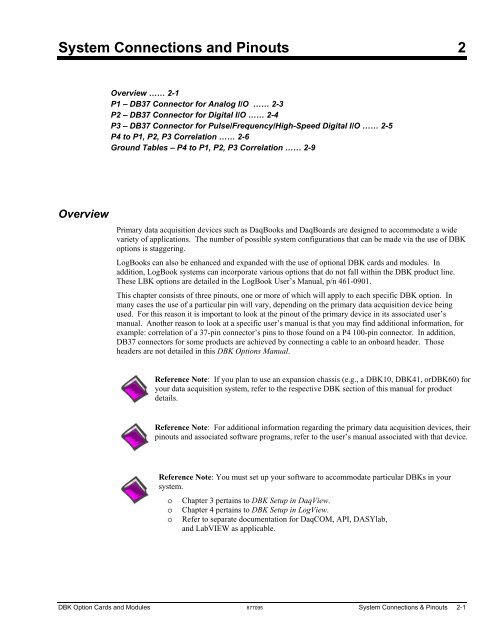OMB-DBK Option Cards and Modules - Omega Engineering
OMB-DBK Option Cards and Modules - Omega Engineering
OMB-DBK Option Cards and Modules - Omega Engineering
Create successful ePaper yourself
Turn your PDF publications into a flip-book with our unique Google optimized e-Paper software.
System Connections <strong>and</strong> Pinouts 2<br />
Overview<br />
Overview …… 2-1<br />
P1 – DB37 Connector for Analog I/O …… 2-3<br />
P2 – DB37 Connector for Digital I/O …… 2-4<br />
P3 – DB37 Connector for Pulse/Frequency/High-Speed Digital I/O …… 2-5<br />
P4 to P1, P2, P3 Correlation …… 2-6<br />
Ground Tables – P4 to P1, P2, P3 Correlation …… 2-9<br />
Primary data acquisition devices such as DaqBooks <strong>and</strong> DaqBoards are designed to accommodate a wide<br />
variety of applications. The number of possible system configurations that can be made via the use of <strong>DBK</strong><br />
options is staggering.<br />
LogBooks can also be enhanced <strong>and</strong> exp<strong>and</strong>ed with the use of optional <strong>DBK</strong> cards <strong>and</strong> modules. In<br />
addition, LogBook systems can incorporate various options that do not fall within the <strong>DBK</strong> product line.<br />
These LBK options are detailed in the LogBook User’s Manual, p/n 461-0901.<br />
This chapter consists of three pinouts, one or more of which will apply to each specific <strong>DBK</strong> option. In<br />
many cases the use of a particular pin will vary, depending on the primary data acquisition device being<br />
used. For this reason it is important to look at the pinout of the primary device in its associated user’s<br />
manual. Another reason to look at a specific user’s manual is that you may find additional information, for<br />
example: correlation of a 37-pin connector’s pins to those found on a P4 100-pin connector. In addition,<br />
DB37 connectors for some products are achieved by connecting a cable to an onboard header. Those<br />
headers are not detailed in this <strong>DBK</strong> <strong>Option</strong>s Manual.<br />
Reference Note: If you plan to use an expansion chassis (e.g., a <strong>DBK</strong>10, <strong>DBK</strong>41, or<strong>DBK</strong>60) for<br />
your data acquisition system, refer to the respective <strong>DBK</strong> section of this manual for product<br />
details.<br />
Reference Note: For additional information regarding the primary data acquisition devices, their<br />
pinouts <strong>and</strong> associated software programs, refer to the user’s manual associated with that device.<br />
Reference Note: You must set up your software to accommodate particular <strong>DBK</strong>s in your<br />
system.<br />
o Chapter 3 pertains to <strong>DBK</strong> Setup in DaqView.<br />
o Chapter 4 pertains to <strong>DBK</strong> Setup in LogView.<br />
o Refer to separate documentation for DaqCOM, API, DASYlab,<br />
<strong>and</strong> LabVIEW as applicable.<br />
<strong>DBK</strong> <strong>Option</strong> <strong>Cards</strong> <strong>and</strong> <strong>Modules</strong> 877095 System Connections & Pinouts 2-1

















